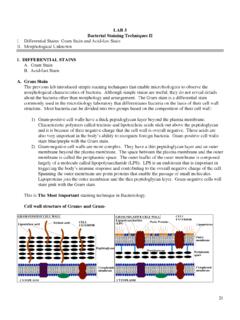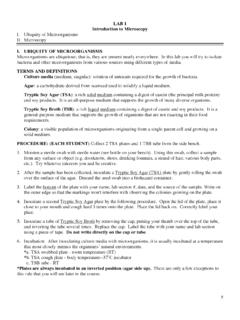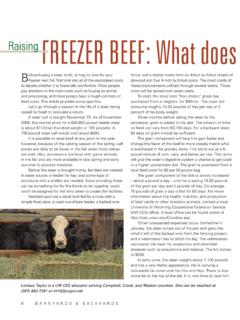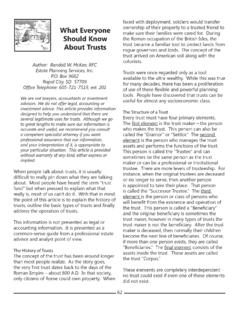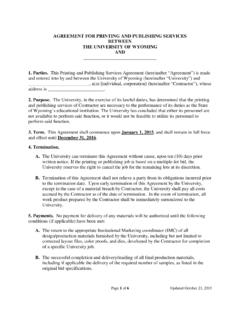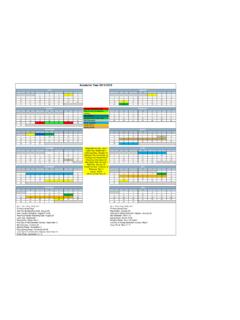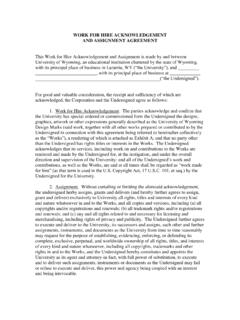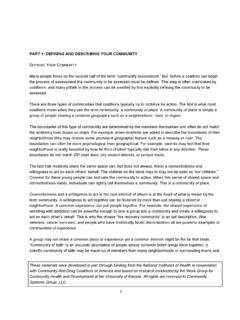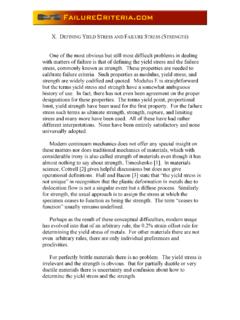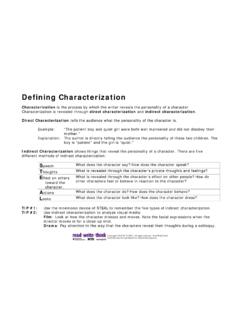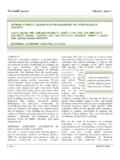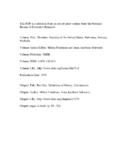Transcription of Observational Study of Behavior: Sampling Methods
1 Observational Study of behavior : Sampling MethodsAuthor(s): Jeanne AltmannSource: Behaviour, Vol. 49, No. 3/4 (1974), pp. 227-267 Published by: BRILLS table URL: .Accessed: 21/01/2014 18:45 Your use of the JSTOR archive indicates your acceptance of the Terms & Conditions of Use, available at ..JSTOR is a not-for-profit service that helps scholars, researchers, and students discover, use, and build upon a wide range ofcontent in a trusted digital archive. We use information technology and tools to increase productivity and facilitate new formsof scholarship. For more information about JSTOR, please contact .BRILL is collaborating with JSTOR to digitize, preserve and extend access to This content downloaded from on Tue, 21 Jan 2014 18:45:39 PMAll use subject to JSTOR Terms and ConditionsOBSERVATIONAL Study OF behavior : Sampling Methods by JEANNE ALTMANN 1) (Allee Laboratory of Animal behavior , University of Chicago, Chicago, Illinois, ) (Rec.
2 I5-III-I973) CONTENTS Page I. Introduction .. 227 II. Sampling variables .. 231 1II. Ad libitum Sampling .. 235 IV. Sociometric matrix completion .. 240 V. Focal-animal Sampling 242 VI. Sampling all occurrences of some behaviors . 247 VII. Sequence Sampling .. 248 VIII. One-zero Sampling .. 25I IX. Instantaneous and scan Sampling .. 258 Summary .. 261 Bibliography .. 262 Zusammenfassung .. 265 I. INTRODUCTION This is an observer's guide: in it I will present Sampling Methods for use in direct observation of spontaneous social behavior in groups of men or other animals. All Observational Sampling Methods known to me will be described, and their uses and limitations indicated.
3 A. SCOPE In what follows I shall assume that the observer has a group of sponta- neously interacting individuals to watch, that he has formulated one or more questions about social behavior , that he knows what behaviors he wishes to Study , and that he has found suitable Methods for recording such behaviors. I) During the preparation of this paper the author was supported by research grants GB-2717o, from the National Science Foundation, and MH-I9,617, from the Public Health Service. The encouragement and criticisms of my husband, Stuart ALTMANN, were of utmost value at all stages of the research and writing. The manuscript benefitted from critical reading of an earlier version by Joel COHEN, Glenn HAUSFATER, James LoY, Donald SADE, Montgomery SLATKIN, Thomas STRUHSAKER and Stephen WAGNER.
4 This content downloaded from on Tue, 21 Jan 2014 18:45:39 PMAll use subject to JSTOR Terms and Conditions228 JEANNE ALTMANN Thus, I will not be concerned here with the logistics of such research nor with the problems of choosing research questions and defining behavior categories. No attempt will be made to cover statistical aspects of exper- imental design, such as adequacy of sample size, factorial design, and so forth. Instead, the focus will be on a question that arises at an earlier stage in research planning, namely, how does the choice of Sampling method restrict the kinds of behavior processes that can be studied? Or, conversely, given a particular behavioral research problem what Sampling Methods are suitable for it?
5 I shall assume that the research question has been sufficiently well- formulated that the investigator can identify the relevant sample space, the set of events that must be sampled in order to answer the question. Let me illustrate. Suppose that we are interested in studying aggression in a group of monkeys. We might begin by formulating a question such as this: Are males more aggressive than females? At this stage, the question is too ambiguous for a Sampling method to be chosen. For example, we need to specify which behaviors will be classed as aggressive, and which will not. We need to make clear whether the question refers to all age classes or, say, just to adults.
6 Even then, there are numerous reasonable interpretations of the question, such as: (i) On the average, do males spend more of the day involved in aggressive behavior than do females ? (ii) Do males initiate aggressive bouts more often than do females? (iii) Are the aggressive acts of males more serious, more intense, more potentially destructive ? (iv) Do the behavioral acts of males include a higher proportion of aggressive acts than do those of females? (v) Is the response to an aggressive act more likely to be an aggressive act if the recipient is a male? The choice of one or more of such formulations depends on an evaluation of their relevance to the original question.
7 That evaluation depends, in turn, on numerous questions about the behavioral or biological significance of sex differences in aggression. Such evaluation lies outside the scope of this paper. But an unambiguous formulation of the research question is a pre- requisite to the kinds of Sampling decisions that will be discussed here: different formulations will usually involve Sampling from different sample spaces. The observer needs to know how to gather data that will answer such specific research questions. Should he repeatedly scan the group, recording This content downloaded from on Tue, 21 Jan 2014 18:45:39 PMAll use subject to JSTOR Terms and ConditionsOBSERVATIONAL Sampling 229 each individual's behavior at the time that it is seen?
8 Should he watch each individual in turn, each for a fixed amount of time? If an individual continues in one observation period the behavior that he began in a previous period, should the behavior be recorded again? Should the observer record every occurrence of a behavior , or only whether it occurred at least once in the observation period ? In this paper, I shall examine such Sampling alternatives and provide guidelines for choosing among them in Observational studies. Sampling decisions are made whenever the student of social behavior cannot continuously observe and record all of the behavior of all of the members of a social group, and must therefore settle for a partial record.
9 However, even in the most systematic of Observational behavior studies, only partial descriptions of the Sampling procedure are provided. Seldom has an author provided justification for his choice of Sampling method. We suspect that the investigator often chooses a Sampling procedure without being aware that he is making a choice. Of course, he does not thereby escape the consequences of the choice: the data that result from any Sampling method can only answer certain classes of questions. From the standpoint of the behavioral questions, a given question can be answered only by data obtained through certain kinds of Sampling Methods . B. MANIPULATIVE VS NON-MANIPULATIVE RESEARCH The method of direct observation plays a curious and unique role in the behavioral sciences.
10 It is at once the necessary link between laboratory research and "real-world" behavior , and the bane of our aspirations for more accurate, more objective information about behavior . From time to time, one hears the claim that accurate studies of behavior can be made only in the laboratory, and that quantitative research on behavior is not practicable in the context of ongoing, real-life situations. Such a restriction on research would mean that the behavioral sciences would for- ever forsake any hope of knowing whether their most powerful theories have any relevance to the world of behavior outside the laboratory. Unless we develop Methods for field research that are comparable in sensitivity to those of the laboratory, the behavioral sciences will become progressively more isolated from the very behavior that their theories are supposed to explain.


